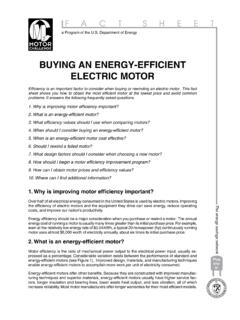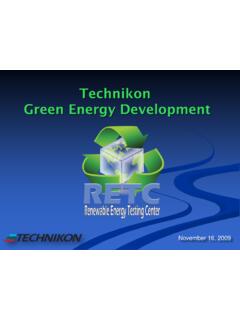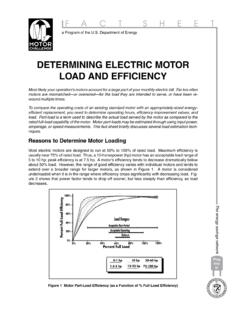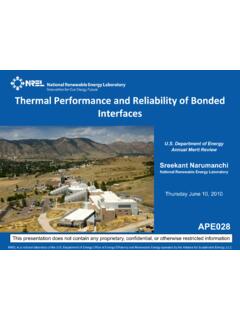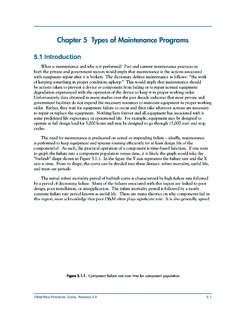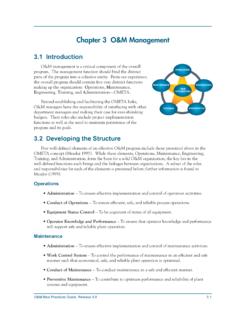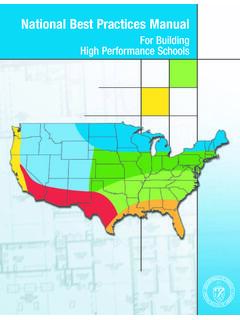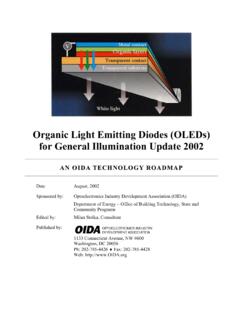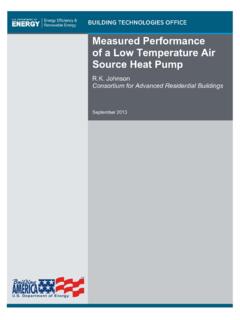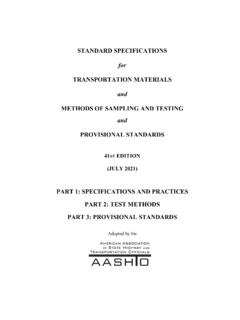Transcription of Building Materials Property Table - Energy
1 BSC Information Building Materials Property Table for All Climates This Table presents some of the key technical properties of many of the most common Building Materials . The information presented has been compiled from: ASHRAE Fundamentals - 2001 Moisture Control in Buildings CMHC NRC/IRC IEA Annex 24 Manufacturer data Sheet 500 When using this information, it MUST be done in the following context: 1. Some of these properties are difficult to measure and very sensitive to small changes in the material . That is why ranges are often given and any single value should be considered "representative." 2. The importance of the numbers is almost always in the context of the numbers for substitute or alternative Materials .
2 3. In order to compare numbers, they must be in the same units and obtained under the same standard test conditions - a very tall order. This is the main reason that a Table like this has never really been compiled before. The Table and its contents will continue to be refined and gaps filled in. 4. The importance of the numbers is almost always in the context of a given Building assembly, for a given climate. 5. There are very few if any bad Building Materials , from a Building science perspective; bad applications, however, abound. 6. The most important column in this Table is likely to be the "Comments" column because it includes the experience/expertise/unique perspective of many of the leading Building scientists in North America.
3 The title of this column could be "OK - now what do these numbers REALLY mean?" Use this Table to augment the information provided in the Building Profiles and Best Practices of the Houses That Work resource. And remember, this resource attempts to supply you with the best knowledge currently available - your professional and field use of it turns it into wisdom. This Table is a work in progress - please direct questions or comments to: BSC Information Sheet 500 for All Climates Building Materials Property Table HPR= Hydrostatic Pressure Resistance (AATCC127) AP = Air permeability (ASTM E2178-01) FS = Flame Spread (ASTM E84) MGI/IC - Mold Growth Index for Interior Coatings (ASTM D3273) MGI/I&F - Mold Growth Index for Insulation & Facings (ASTM C1338) SD = Smoke Development (ASTM E84) WA = Water Adsorption (ASTM C209) material Typical Relevant Dimension Water Vapor Permeability (perm-inch)1 Water Absorption2 R-Value Other Relevant Properties Comments Web Link for More Information Dry Cup Wet Cup Exterior Sheathings Plywood (CDX)
4 3/8" na FS =76-200 SD =130 At saturation, factor of 10 increase in permeability -- 14 - perms More Information OSB 3/8" 2 na FS = 148 SD= 137 At saturation, marginal increase in permeability - - perms More Information Fiberboard -asphalt impregnated 7/16" 15 - 7% FS > 75 AP= Among the most vapor permeable of exterior sheathings More Information More Information Thin profile structural sheathing .078" - .137" - - na - R-value dependent on air space; this sheathing is essentially an exterior vapor barrier More Information Foil-faced PIR insulation 1" 0% 7 FS = 5 SD = 165 Combined thermal, vapor transmission & combustion properties must be used appropriately More Information XPS rigid insulation 1" 1 1 5 FS = 5 SD = 165 Compare/contra st moisture properties to More Information Building Materials Property Table 2 of 8 BSC Information Sheet 500 for All Climates AP=0 EPS, CAREFULLY XPS (skinned) 3/8" 0?
5 0? Polypro skin enables the fan fold but can be removed and greatly affects vapor permeability EPS rigid insulation (Type II - pcf density) 1" 3% FS = 20 CD = 150 -300 There are lots of different grades and densities- and hence toughness--of EPS. Make sure you specify by Type (they range from Type I 1 pcf to Type IX 2 pcf) More Information Glass mat faced gypsum board (DensGlass ) 1/2" 23 5% FS = 0 SD = 0 Among the most vapor permeable of exterior sheathings More Information Wall Claddings Brick 31/2" - Properties as variable as the material but water storage capacity is always very high More Information Traditional stucco 7/8" Properties as variable as the material but almost always has relatively high vapor permeability Polymer-modified stucco Vapor permeability is dependent on paint - with latex paint generally in the 2-3 perm range; with elastomeric paint highly variable.
6 Wood lap siding (unfinished) 3/8" "35 perms" FS = 69 SD = 98 35 perms is an equivalent vapor permeance value. Based on both empirical Building Materials Property Table 3 of 8 BSC Information Sheet 500 for All Climates tests (laboratory and test hut conditions), the value is obtained under the following conditions: a 1 Pa air pressure difference between the cladding and environment; crack width between courses of 3/1000 of an inch; and crack length of 18 inches. Note that this value is independent of finishes or coatings on the wood, unless the treatment closes the width or reduces the length of the space between courses. Fibercement lap siding (primed all surfaces) 5/16" FS = 0 CD = 5 Siding comes in different finishes, including texture and coatings (factory priming).
7 Product must be installed over top of a weather barrier--BSC also recommends over furring strips. More Information Vinyl lap siding n/a "70 perms" 70 perms is an equivalent vapor permeance value. Based on both empirical tests (laboratory and test hut conditions), the value is obtained under the following conditions: a 1 Pa air pressure difference between the cladding and More Information Building Materials Property Table 4 of 8 BSC Information Sheet 500 for All Climates environment; crack width between courses of 2 sheets of paper; and crack length of 18 inches. Interior Wallboards Standard paper-faced 1/2" 40 FS = 15 SD = 0 Both faces and core highly water vapor permeable; paper faces highly susceptible to mold and mildew growth.
8 DensArmor Plus 1/2" 12 23 5% FS = 10 SD = 0 Paper facings are replaced with fiberglass mat facings for increased resistance to moisture, mold and mildew. More Information Fiberock 1/2" Hardie Tilebacker Hardie Backerboard 500 13/32" FS = 0 SD - 5 More Information DensShield 1/2" A tilebacker board with the top face acrylic coating acting as water and moisture barrier. More Information Durock 1/2" Non-paper faced gypsum board: Fiberock Aqua-TOUGH 1/2" 35 .5 FS = 5 SD = 0 Drainage pattern is embossed on back surface of sheathing More Information Cavity Fill Insulations Fiberglass/Rockw ool (unfaced batt) 31/2" 120 168 11 FS = 10 SD = 10 The thermal performance of all batt insulation depends on independent air sealing components and details.
9 More Information Building Materials Property Table 5 of 8 BSC Information Sheet 500 for All Climates Cellulose 31/2" 75 <15% 13 FS < 25 SD < 50 While the air tightness of cellulose insulation is significantly better than some other common cavity fill insulation, it's thermal performance still depends on independent air sealing components and details. More Information Icynene - modified spray urethane 31/2" 16 0% FS < 20 SD < 400 AP = While all spray foams are excellent for air sealing, they vary, often widely, in their density, R-value, blowing agent, water resistance, vapor permeability.
10 These last two can have the greatest affect on just how you use spray foam in various Building assemblies. More Information Flooring Hardwood 3/4" Softwood 3/4" Glazed tile 3/8" Synthetic carpet Organic fiber carpet Linoleum Vinyl tile essentially vapor impermeable--not recommended with concrete floors, particularly with Building Materials Property Table 6 of 8 BSC Information Sheet 500 for All Climates high w/c ratios Vinyl sheet 1/32" - 1/16" essentially vapor impermeable- not recommended with concrete floors, particularly with high w/c ratios Vapor Dry Cup Permeanc e (Perms)1 Wet Cup Air Permeance (L/s*m2@75 Pa) Sheet Good Building Products No.
